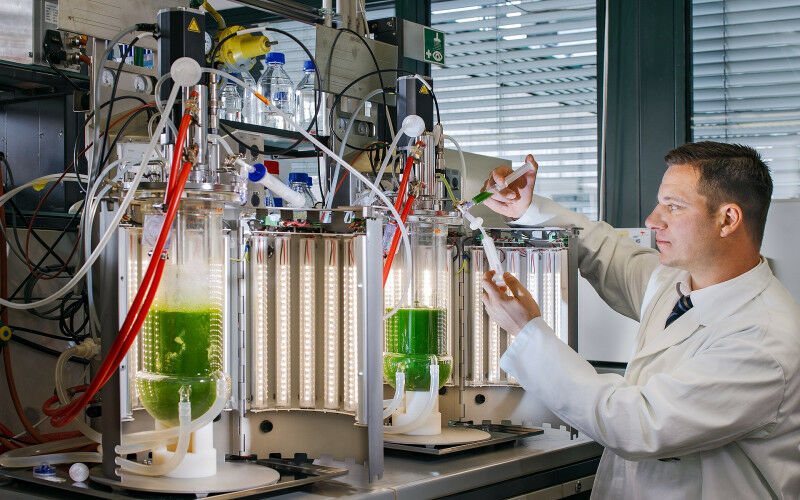博文
用生物质回收稀土
||
用生物质回收稀土
诸平


据德国慕尼黑工业大学(Technical University of Munich / Technische Universität München简称TUM)2023年2月28日提供的消息,该校的研究人员与德国皮尔马森斯的凯泽斯劳滕应用科学大学(University of Applied Sciences Kaiserslautern, Pirmasens, Germany)的研究人员合作,利用生物质回收稀土(Recycling Rare Earths with biomass)。
上述图1是托马斯·布吕克(Thomas Brück)教授在慕尼黑工业大学自然科学学院化学系的维尔纳·西门子主席的合成生物技术(Werner Siemens-Chair of Synthetic Biotechnology)的光生物反应器上取样。研究人员使用这些生物反应器来生产用于研究的蓝藻菌株(cyanobacteria)的生物质。
以前未研究的蓝藻菌株可以吸附金属(Previously uninvestigated strains of cyanobacteria can adsorb metals)
稀土金属对于无数高科技应用来说都是必不可少的。慕尼黑工业大学 (TUM) 的一个研究小组与凯泽斯劳滕应用科学大学的研究人员合作,现已成功使用以前未研究过的细菌菌株从水溶液中回收这些有价值的金属。相关研究结果于2023年2月28日已经在《生物工程与生物技术前沿:生物过程工程》(Front. Bioeng. Biotechnol., Sec. Bioprocess Engineering)杂志网站发表——Michael Paper, Max Koch, Patrick Jung, Michael Lakatos, Tom Nilges, Thomas B. Brück. Rare Earths Stick to Rare Cyanobacteria: Future Potential for Bioremediation and Recovery of Rare Earth Elements. Front. Bioeng. Biotechnol., Sec. Bioprocess Engineering, 28 February 2023. Volume 11. DOI: 10.3389/fbioe.2023.1130939. https://www.frontiersin.org/articles/10.3389/fbioe.2023.1130939/full
风力涡轮机、催化转换器、光缆和等离子监视器:它们都含有稀土金属。由于这17种金属元素(总称稀土元素)是现代技术不可或缺的,因此成本和需求不断上升。可开采矿床有限,生产往往困难重重且对环境有害。尽可能有效地回收这些资源,例如从采矿、电子和化学催化剂等领域产生的工业废水中回收它们,显然是有益的。
TUM研究人员使这些广受欢迎的金属向循环经济(Circular Economy)迈进了一大步:科学家们研究了几种蓝藻菌株从水溶液中吸附稀土金属的潜力-并取得了成功。“另一个巨大的好处是该过程是可逆的,”TUM合成生物技术的维尔纳·西门子主席(TUM’s Werner Siemens-Chair of Synthetic Biotechnology)托马斯·布吕克教授解释说,“这意味着我们可以将金属从溶液中清洗出来,然后再利用生物质。”
在极端栖息地发现的细菌(Bacteria found in extreme habitats)
托马斯·布吕克和他的同事确定了12种蓝藻菌株对稀土金属镧(lanthanum, La)、铈(cerium, Ce)、钕(neodymium, Nd)和铽(terbium, Tb)的所谓“生物吸附”的潜力。这些菌株中的大多数从未就其生物技术潜力进行过研究。它们生活在环境条件恶劣的栖息地,例如纳米比亚的沙漠(Namibian deserts)、乍得的碱湖(soda lakes in Chad)、南非的岩石裂缝(rock crevices in South Africa)和瑞士污染的溪流(polluted streams in Switzerland)。
正如科学家在实验室测试中所证明的那样,所研究的蓝藻能够吸附相当于其干重10%的稀土金属。上述论文的主要作者迈克尔·拉卡托斯(Michael Lakatos)说:“蓝藻生物质中含有大量带负电荷的糖化合物。这些糖化合物会吸引带正电荷的金属离子,然后这些离子会与生物质结合。”
快速高效(Fast and efficient)
研究人员还观察到,蓝藻对稀土金属的生物吸附甚至在低浓度金属的情况下也是可能的。这个过程也很快:例如,溶液中的大部分铈(Ce)在反应开始后5分钟内结合。
现在,在后续的项目中,科学家们计划进行更多更大规模的实验,以进一步提高成果的工业应用。
该项目由德国巴伐利亚州环境和消费者保护部(Bavarian State Ministry of the Environment and Consumer Protection)在ForCycle II项目组(ForCycle II Project Group.)的框架下资助。也得到了德国莱茵兰-普法尔茨州科学与卫生部{ Ministry of Science and Health Rhineland-Palatinate (PhytoBioTech, 724–0116#2021, 004–1501 15405)}、联邦教育与研究部{ Federal Ministry of Education and Research (W2V-Strategy2Value, 03WIR4502A & Technology2Value 03WIR4504B)}以及EU-HORIZON (Waste2BioComp ID: 101058654)。另外也得到了德国研究委员会{ German Research Council (DFG; Grit Life; JU 3228, 1–1)}的资助。
上述介绍,仅供参考。欲了解更多信息,敬请注意浏览原文或者相关报道。
Biosorption of metal ions by phototrophic microorganisms is regarded as a sustainable and alternative method for bioremediation and metal recovery. In this study, 12 cyanobacterial strains, including 7 terrestrial and 5 aquatic cyanobacteria, covering a broad phylogenetic diversity were investigated for their potential application in the enrichment of rare earth elements through biosorption. A screening for the maximum adsorption capacity of cerium, neodymium, terbium, and lanthanum was conducted in which Nostoc sp. 20.02 showed the highest adsorption capacity with 84.2–91.5 mg g-1. Additionally, Synechococcus elongatus UTEX 2973, Calothrix brevissima SAG 34.79, Desmonostoc muscorum 90.03, and Komarekiella sp. 89.12 were promising candidate strains, with maximum adsorption capacities of 69.5–83.4 mg g-1, 68.6–83.5 mg g-1, 44.7–70.6 mg g-1, and 47.2–67.1 mg g-1 respectively. Experiments with cerium on adsorption properties of the five highest metal adsorbing strains displayed fast adsorption kinetics and a strong influence of the pH value on metal uptake, with an optimum at pH 5 to 6. Studies on binding specificity with mixed-metal solutions strongly indicated an ion-exchange mechanism in which Na+, K+, Mg2+, and Ca2+ ions are replaced by other metal cations during the biosorption process. Depending on the cyanobacterial strain, FT-IR analysis indicated the involvement different functional groups like hydroxyl and carboxyl groups during the adsorption process. Overall, the application of cyanobacteria as biosorbent in bioremediation and recovery of rare earth elements is a promising method for the development of an industrial process and has to be further optimized and adjusted regarding metal-containing wastewater and adsorption efficiency by cyanobacterial biomass.
https://blog.sciencenet.cn/blog-212210-1378421.html
上一篇:《自然》:中美科学家利用电化学将二氧化碳转化为有用的分子
下一篇:“塑化症”:一种由塑料引起的影响海鸟的新疾病
